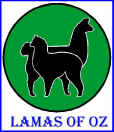
GENERAL LAMA (LLAMA & ALPACA) FACTS
Back when we named our farm Lamas of OZ, "lama"
was the genus which included the llama (lama glama), alpaca (lama pacos) & guanaco
(lama guanacoe) while "vicugna" was the genus for the vicuna (vicugna
vicugna). Research has found that the alpaca descended from the vicuna and the
alpaca is now "vicugna pacos." Please forgive us for continuing to use
"lama" to include both llama & alpaca.
- Lamas live 15 – 25 years
- Lamas eat grass, hay & grain
- Lamas have 3 stomach compartments & chew their cud like cows
- Lamas have communal dung piles (they all "go" in the same place) – easy to clean up
- Lamas have a very soft padded foot with 2 toenails
- Lamas are very intelligent & can be trained to lead in just a few repetitions
- Lamas have excellent eyesight
- Lamas are very gentle animals
- Lama mothers and babies hum to each other
- Lamas have a shrill alarm call when they are afraid
- Lama manure makes very good fertilizer – better than any other livestock
ALPACAS
- Alpacas have only been in Canada since 1984
- Adult alpacas weigh 105-180 pounds
- They produce 5-10 pounds of very soft warm fleece (wool) per year
- There are 2 types of alpaca: huacaya (puffy like a sheep) & suri (flatter, stringy fleece)
- Alpacas come in 22 natural colours including black, white, gray, beige, brown, maroon
LLAMAS
- Adult llamas weigh 280-475 lbs
- Llamas also have very warm soft fleece but it contains more guard hair (coarser hair) than alpaca
- Llamas come in about as many colours as alpacas and in any imaginable pattern